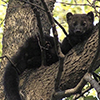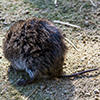Minnesota Mammals
Mammalia (mammals) is the class of animals that is distinguished as having 3 middle ear bones, hair, mammary glands, and a neocortex (a region of the brain).
The number of recognized, still living (extant), mammal species worldwide has grown significantly in the last two decades. Mammal Species of the World published a database in 2005 listing 5,416 mammal species, of which one is extinct. The International Union for Conservation of Nature and Natural Resources (IUCN) in 2024 lists 5,980 mammal species.
The American Society of Mammalogists (ASM) performed a review of taxonomic changes published since 2004 and compiled a comprehensive list of mammal species. The results were published in 2018 as the Mammal Diversity Database. The database listed 6,495 total species, of which 6,399 are extant and 96 were recently extinct. The current version of the Mammal Diversity Database, v1.12.1, released January 30, 2024, lists 6,718 mammal species in 1,351 genera in 167 families in 27 orders worldwide. Of those, 6,611 species are extant and 107 are recently extinct.
There are 474 mammal species in 166 genera in 46 families currently found in North America north of Mexico and its adjacent waters. There are 78 mammal species native to and currently found in Minnesota.
Higher Taxonomy in Mammals: Our Classification Standard
The classification of mammals above the family level is a highly dynamic field, continually refined by modern scientific advancements, particularly DNA analysis and cladistic methodology. This ongoing research means that no single taxonomic system is universally accepted across all digital and academic platforms.
For the most accurate and current representation of mammal species, MinnesotaSeasons.com now follows the standards set by the Mammal Diversity Database (MDD), which is maintained by the American Society of Mammalogists (ASM).
We recognize that the MDD's classification may differ from other sources you encounter, such as ITIS/Catalogue of Life, iNaturalist, or Wikipedia. We choose the MDD because it represents the most recent peer-reviewed consensus in mammalogy.

Recent Additions

Least chipmunk (Neotamias minimus) is the most widespread and also the smallest of the North American chipmunks. In Canada it occurs from Ontario to Yukon Territory. In the United States it occurs west of the Great Plains and in the upper Great Lakes region. In Minnesota it occurs in the Arrowhead and north-central regions. It is found at the edges and in the openings, clearcuts, and disturbed areas of coniferous and mixed forests. It eats seeds, nuts, fruits, acorns, snails, insect eggs and larvae, and small birds and mammals. It nests under stumps, logs, and rocks. It winters in a burrow it digs that reaches up to one meter underground. When running it holds its tail erect.
The adult is 7¼″ to 8¾″ long. It weighs about half as much as an eastern chipmunk. The coat (pelage) on the sides is reddish-brown in the front, grayish brown in the rear. The rump is grayish-brown. There are five dark brown or black stripes on the back separated by white or cream-colored stripes. The middle stripe stretches from the nape of the neck to the base of the tail. On each side of the face there are three dark brown stripes separated by two white or cream-colored stripes. The facial stripes are well defined and highly visible. The tail is orangish-brown, and bushy.

Franklin’s ground squirrel (Poliocitellus franklinii) is a medium-sized squirrel but a large ground squirrel. It is the largest and darkest ground squirrel in its range. It occurs in the tallgrass prairie region in the United States and Canada. It is considered scarce in Minnesota. It is found in areas with tall vegetation including edges of fields and prairies, open woodlands, and edges of marshes.
Franklin’s ground squirrel is superficially similar in appearance to an eastern gray squirrel but it is smaller and has a shorter, less bushy tail, shorter ears, and a more pointed snout. The coat (pelage) is short and dark gray with pale and dark flecks and a brown wash over the back and rump.
Franklin’s ground squirrel spends most of its time in an underground burrow that can be up to 8 feet deep. It is tolerant of humans and can be seen at camp sights, in state parks, and at dumps. It is omnivorous, feeding on plants, ground nesting bird eggs, insects, and small animals, including other ground squirrels.

American badger (Taxidea taxus) is a solitary, medium-sized, common but seldom seen, carnivorous mammal. It is a solitary animal, active mostly at night but also often during the day, especially in early morning. It has a home range of about 1 square mile in which it may have up to 46 burrows. It is a good digger, the only mammal that can dig out pocket gophers. It eats mostly ground squirrels and pocket gophers, but also voles, mice, reptiles (including rattlesnakes), amphibians, ground-nesting birds and their eggs, insects, and other invertebrates.
Badgers are easily recognized. The low, flattish profile and white middorsal head stripe are diagnostic. The common name is thought to refer to the black “badge”-shaped markings on their cheeks. There are four, fifteen, or twenty-one subspecies of badger in North America, depending on who you ask. All sources recognize the two subspecies found in Minnesota. Common badger, the largest subspecies, is found in the western border counties. Jackson’s badger, typically darker and smaller, is found in the remainder of the state.

Northern short-tailed shrew (Blarina brevicauda) is the only poisonous mammal on the North American mainland. Its poisonous bite allows it to paralyze its prey and eat it at a later time. It is sufficiently strong to kill animals up to the shrew’s size, and to produce a very painful reaction in humans who handle the shrew.
It has a poor sense of smell and very poor vision. It can navigate and detect objects in its environment using echolocation and and touch. Like bats, it emits a series of ultrasonic squeaks to detect its surroundings. Unlike bats, it does not use echolocation to locate prey. Its snout and whiskers are highly sensitive to touch.
There are 385 species of shrew worldwide, 7 in Minnesota. Northern short-tailed shrew is the largest and most widespread in eastern North America and the most common in Minnesota. The combination of large size and short tail distinguish this from all other shrew species in Minnesota.

There are six species of voles found in Minnesota. Southern red-backed vole (Myodes gapperi) is one of the smallest. It is common in moist deciduous, coniferous and mixed forests with stumps and logs for ground cover. It is usually the most common rodent in cedar, tamarack, and black spruce swamps. It is active both during the day and at night but more often at night. It is solitary, not forming colonies or pair bonds. It forages mostly on the ground but also in trees. This is the only vole in Minnesota that is a good climber of trees.
Southern red-backed vole is distinguished from mice by a stouter body; shorter, hairy tail; smaller ears and eyes; and molars with high crowns and angular cusps. It is easily distinguished from other voles by the gray sides and reddish back.
Other Recent Additions
This list includes only mammals that have been recorded in Minnesota, but not all of the mammals found in Minnesota.
| Profile | Photo | Video | |||
|---|---|---|---|---|---|
American pygmy shrew (Sorex hoyi) |
|||||
American water shrew (Sorex palustris) |
|||||
arctic shrew (Sorex arcticus) |
|||||
eastern heather vole (Phenacomys ungava) |
|||||
eastern mole (Scalopus aquaticus) |
|||||
ermine (Mustela erminea) |
|||||
hoary bat (Lasiurus cinereus) |
|||||
house mouse (Mus musculus) |
|||||
least weasel (Mustela nivalis) |
|||||
little brown bat (Myotis lucifugus) |
|||||
long-tailed weasel (Neogale frenata) |
|||||
masked shrew (Sorex cinereus) |
|||||
meadow jumping mouse (Zapus hudsonius) |
|||||
North American least shrew (Cryptotis parva) |
|||||
northern bog lemming (Synaptomys borealis) |
|||||
northern grasshopper mouse (Onychomys leucogaster) |
|||||
northern myotis (Myotis septentrionalis) |
|||||
northern pocket gopher (Thomomys talpoides) |
|||||
Norway rat (Rattus norvegicus) |
|||||
plains pocket mouse (Perognathus flavescens) |
|||||
prairie shrew (Sorex haydeni) |
|||||
Richardson’s ground squirrel (Spermophilus richardsonii) |
|||||
rock vole (Microtus chrotorrhinus) |
|||||
silver-haired bat (Lasionycteris noctivagans) |
|||||
smoky shrew (Sorex fumeus) |
|||||
southern bog lemming (Synaptomys cooperi) |
|||||
southern flying squirrel (Glaucomys volans) |
|||||
western harvest mouse (Reithrodontomys megalotis) |
|||||
woodland caribou (Rangifer tarandus caribou) |
|||||
woodland deer mouse (Peromyscus maniculatus gracilis) |
|||||
woodland jumping mouse (Napaeozapus insignis) |
|||||
woodland vole (Microtus pinetorum) |
|||||
|
|||||
|
|||||
|
|||||
|
|||||
|
|||||
|
|||||
|
|||||
|
|||||
|
|||||
|
|||||
|
|||||
|
|||||
|
|||||
|
|||||
|
|||||
|
|||||
|
|||||
|
|||||
|
|||||
|
|||||
|
|||||
|
|||||
|
|||||
|
|||||
|
|||||
|
|||||
|
|||||
|
|||||
|
|||||
|
|||||
|
|||||
|
|||||
|
|||||
|
|||||
|
|||||
|
|||||
|
|||||
|
|||||
|
|||||
|
|||||
|
|||||
|
|||||
|
|||||
|
|||||
|
|||||
|
|||||
|
|||||
|
|||||
|
Blarina brevicauda (northern short-tailed shrew)
Castor canadensis (American beaver)
Clethrionomys gapperi (southern red-backed vole)
Condylura cristata (star-nosed mole)
Cryptotis parva (North American least shrew)
Didelphis virginiana (Virginia opossum)
Eptesicus fuscus (big brown bat)
Erethizon dorsatum (North American porcupine)
Geomys bursarius (plains pocket gopher)
Glaucomys sabrinus (northern flying squirrel)
Glaucomys volans (southern flying squirrel)
Ictidomys tridecemlineatus (thirteen-lined ground squirrel)
Lasionycteris noctivagans (silver-haired bat)
Lasiurus borealis (eastern red bat)
Lasiurus cinereus (hoary bat)
Lepus americanus (snowshoe hare)
Lepus townsendii (white-tailed jackrabbit)
Lontra canadensis (North American river otter)
Martes americana (American marten)
Mephitis mephitis (striped skunk)
Microtus chrotorrhinus (rock vole)
Microtus drummondii (western meadow vole)
Microtus ochrogaster (prairie vole)
Microtus pinetorum (woodland vole)
Mus musculus (house mouse)
Mustela erminea (ermine)
Mustela nivalis (least weasel)
Myotis lucifugus (little brown bat)
Myotis septentrionalis (northern myotis)
Napaeozapus insignis (woodland jumping mouse)
Neogale frenata (long-tailed weasel)
Neotamias minimus (least chipmunk)
Odocoileus virginianus (white-tailed deer)
Onychomys leucogaster (northern grasshopper mouse)
Perimyotis subflavus (tricolored bat)
Perognathus flavescens (plains pocket mouse)
Peromyscus leucopus (white-footed mouse)
Peromyscus maniculatus bairdii (prairie deer mouse)
Peromyscus maniculatus gracilis (woodland deer mouse)
Phenacomys ungava (eastern heather vole)
Poliocitellus franklinii (Franklin’s ground squirrel)
Procyon lotor (common raccoon)
Rangifer tarandus caribou (woodland caribou)
Rattus norvegicus (Norway rat)
Reithrodontomys megalotis (western harvest mouse)
Scalopus aquaticus (eastern mole)
Sciurus carolinensis (eastern gray squirrel)
Sorex arcticus (arctic shrew)
Sorex cinereus (masked shrew)
Sorex fumeus (smoky shrew)
Sorex haydeni (prairie shrew)
Sorex hoyi (American pygmy shrew)
Sorex palustris (American water shrew)
Spermophilus richardsonii (Richardson’s ground squirrel)
Spilogale interrupta (plains spotted skunk)
Sylvilagus floridanus (eastern cottontail)
Synaptomys borealis (northern bog lemming)
Synaptomys cooperi (southern bog lemming)
Tamias striatus (eastern chipmunk)
Tamiasciurus hudsonicus (American red squirrel)
Taxidea taxus (American badger)
Thomomys talpoides (northern pocket gopher)
Urocyon cinereoargenteus (gray fox)
Ursus americanus (American black bear)
Zapus hudsonius (meadow jumping mouse)
No Species Page Yet?
If you do not see a linked page for a species in the list at left you can still upload a photo or video or report a sighting for that species. Click on one of the buttons below and type in the common name and/or scientific name of the species in your photo, video, or sighting. A new page will be created for that species featuring your contribution.
These buttons not working for you?
Simply email us at info@MinnesotaSeasons.com.
Capitalization of Common Names
Some authors capitalize mammal common names, but this is controversial and generally not accepted.











































